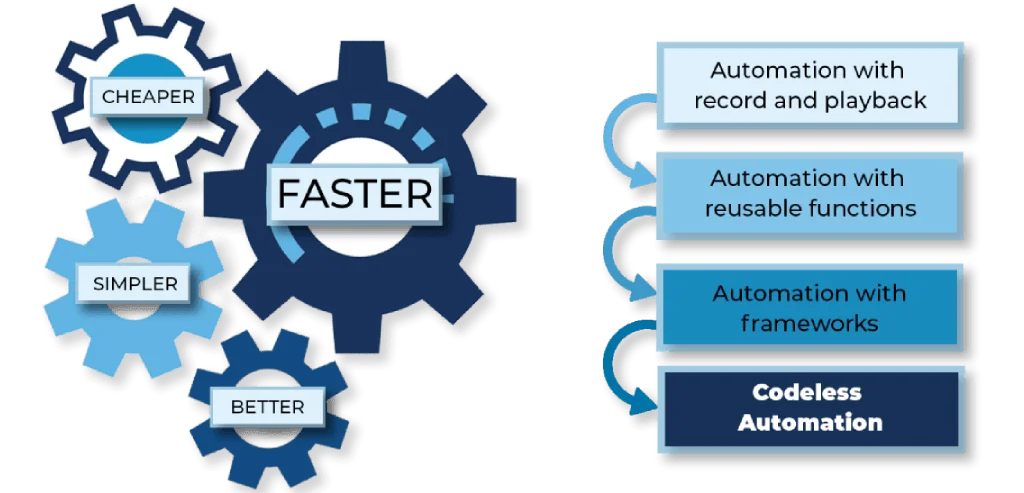Testing saves you from that single software bug that breaks your product down and causes financial losses to organization. With the growing adoption of development, testing also needs to provide more agility to implement changes and execute release cycles. This can be achieved with quicker testing methods and eliminating the overengineering of the testing process. Let’s understand more about advantages of codeless test automation.
Manual testing is useful in many cases. But it fails under the deluge of multiple programming languages, integrations, reusability, constant changes in the application and continuous testing. For instance, Add performance testing, load testing and/or user experience testing to the mix and testing can become tedious, inaccurate and lengthy. However Test automation in such cases does make a lot of sense. But with test automation, if we can make the whole experience codeless, then it becomes a bonus to the engineers. Codeless automation also helps individuals who do not know how to code and can test as well. It also helps companies who do not have to rely to extensive skillsets to run the testing tasks for them.

Test Automation and Codeless Testing
Test Automation is now becoming a necessary requirement for an agile framework. Especially when every release requires the execution of a lot of test cases and actions. Conventional automation testing involved record and play with a series of actions recorded for every test case generated. Initial days of test automation generated unstable scripts. Changes in the application were not tracked easily and changes had to be made to the test cases to run it.
For large projects with a fast release cycle, this entailed a huge effort that took an exhaustive amount of time. This ultimately worked against the whole motive of automation testing, which was aimed to reduce time, resources, and effort.
Advantages of Codeless Test Automation
In the recent years, codeless test automation tools have started gaining limelight as a critical solution to problems for QA teams surrounding test automation. Why? Codeless test automation lets organizations deal with their fast-paced product development, the growing complexity of the testing environment, and the widening gap in the tester’s skill sets.
Codeless test automation helps you implement automation test cases without writing a single line of code. This approach has witnessed steady evolution with new innovation on technology that focuses on reducing the coding process and making it user friendly. This way automating a test scenario takes a negligible amount of time and requires almost zero coding effort, making the process truly codeless.
Tools that add an abstraction layer on top of it all provide that extra advantage, as it translates mapped scenarios to test scripts automatically. This layer is user-friendly with a great graphical interface that makes the testing process easy as you don’t really need code to run those test scripts, and these tools still run-on scripts and several lines of codes that you don’t see on the front-end.
Advantages of codeless test automation
It is surely possible. While 4th generation frameworks provided record and play and still requires test cases and scripting, the 5th generation tools remove the elements of record and play. Domain intuitive, easy to use with simple drag and drop options and a layer of abstraction is the order of the day. We can generate test cases and test scripts automatically through auto coding. With codeless test automation, anyone can test. We can easily carry out Continuous testing and regression testing, with repetitive work patterns with codeless test automation. Some of the benefits one can derive of codeless test automation are:
- Anyone can automate testing – With codeless test automation, testers now have full control over the testing process. Non-programmers are also able to design and execute test scripts. We can generate test scripts even if the user has limited or no knowledge of programming languages or coding. Alongside, executable automated scripts, we can generate test cases in readable languages that do not rely on any code. Non-technical Stakeholders can easily understand and review test scripts
- Better test coverage – It is very efficient as this now does not rely on the tester’s skills alone. Automation of test cases ensures test creation is quick and efficient, thereby testing the product faster and releases to market.
- Empowering the agile methodology – We can incorporate changes quickly and test reusability is higher with codeless test automation. It can support test driven development thus giving agile methodology a boost.
Conclusion –
It is surely a huge progress for testing as a whole. With its ease of use, easy implementation and maintenance, adoption of this will pick pace quickly in the coming years. And we believe this too. Hence, our product, algoQA revolves around that latest of codeless testing. In conclusion, Anyone can test with algoQA. Auto – coding and Self-learning form the heart of the platform. Know more about the product
Get in touch with us for a demo.
You can also read-
The World of Web Real-Time Communication (WebRTC)-Automated Testing for WebRTC-based Applications
Improving Digital Commerce Conversions through Intelligent Test Automation


